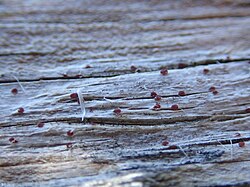Biology:Agyrium
| Agyrium | |
|---|---|

| |
| Agyrium rufum | |
| Scientific classification | |
| Domain: | Eukaryota |
| Kingdom: | Fungi |
| Division: | Ascomycota |
| Class: | Lecanoromycetes |
| Order: | Pertusariales |
| Family: | Agyriaceae |
| Genus: | Agyrium Fr. (1822) |
| Type species | |
| Agyrium rufum (Pers.) Fr. (1822)
| |
| Species | |
|
A. aurantium | |
| Synonyms[1] | |
| |
Agyrium is a genus of saprophytic fungi in the family Agyriaceae. It probably evolved from a lichen ancestor, as it is closely related to many lichenized species of fungi.[2]
Taxonomy
Agyrium was first proposed by Elias Magnus Fries in his 1821 work Systema Mycologicum,[3] although the name was not published validly as a type species was not indicated;[4] Fries published the name validly a year later in the second volume of the same work.[5] The species Agyrium rufum was assigned as the type by Frederic Clements and Cornelius Lott Shear in 1931.[6]
Description
Characteristics of genus Agyrium include the following: a poorly developed thallus that is immersed in its substrate; ascomata in the form of an apothecium with a reduced ring-shaped exciple (the layer surrounding the hymenium that sometimes develops into a distinct margin); paraphyses that are highly branched; and ascospores that are ellipsoid and thin-walled.[7]
The mycelia of Agyrium fungi, although not strictly lichenised, are associated with and sometimes penetrate green algae – particularly near the apothecia.[7] This is a condition that has been described as "facultative parasitism".[8]
Species
(As of May 2021), Species Fungorum accepts two species of Agyrium.
- Agyrium aurantium W.Y.Zhuang & Zhu L.Yang (2006)
- Agyrium rufum (Pers.) Fr. (1822)
The type species, Agyrium rufum, has a largely Northern Hemisphere distribution and occurs widely in Europe, although it has also been recorded in Tasmania.[7] Agyrium aurantium occurs in China.[9]
Although 46 taxa have been placed in Agyrium since its inception, many of them were described more than a century ago and have not been investigated with modern molecular techniques. Several of them have since been transferred to other genera. For example:
- Agyrium caesium Fr. (1822) = Puttea caesia
- Agyrium densum Fuckel (1871) = Mellitiosporiella densa
- Agyrium flavescens Rehm (1903) = Skyttella mulleri
- Agyrium nigricans Fr. (1822) = Platygloea nigricans
- Agyrium nitidum Lib. (1834) = Agyriella nitida
- Agyrium phragmiticola Hansf. (1946) = Neottiosporina phragmiticola
- Agyrium solidaginis (Ces.) De Not. (1863) = Ploettnera solidaginis
- Agyrium vulpinum (Tul.) H.Olivier = Phacopsis vulpina
References
- ↑ "Agyrium Fr., Syst. mycol. (Lundae) 2(1): 210, 231 (1822)". Species Fungorum. http://www.speciesfungorum.org/Names/SynSpecies.asp?RecordID=93.
- ↑ Esslinger, T. L. 2009. A cumulative checklist for the lichen-forming, lichenicolous and allied fungi of the continental United States and Canada. North Dakota State University. First posted December 1 1997; most recent update 27 August, 2009. Fargo, North Dakota.
- ↑ Fries, E.M. (1821) (in la). Systema mycologicum : sistens fungorum ordines, genera et species, huc usque cognitas, quas ad normam methodi naturalis determinavit. 1. Lundin: Ex Officina Berlingiana. p. lv. https://www.biodiversitylibrary.org/page/4338028.
- ↑ "Record Details: Agyrium Fr., Syst. mycol. (Lundae) 2(1): 210, 231 (1822)". Index Fungorum. http://www.indexfungorum.org/names/NamesRecord.asp?RecordID=93.
- ↑ Fries, E.M. (1821) (in la). Systema mycologicum : sistens fungorum ordines, genera et species, huc usque cognitas, quas ad normam methodi naturalis determinavit. 2. Gryphiswaldae: Sumtibus Ernesti Mauritii. pp. 210, 231. https://bibdigital.rjb.csic.es/viewer/10326/?offset=#page=214&viewer=picture&o=bookmark&n=0&q=.
- ↑ Clements, Frederic E.; Chear, Cornelius L. (1931). The Genera of Fungi. New York: H.W. Wilson Company. p. 331. https://www.biodiversitylibrary.org/page/4699950.
- ↑ 7.0 7.1 7.2 Kantvilas, G. (2002). "Agyrium Fr., Bryophagus Nitschke ex Arnold and Racodium Fr., lichen genera previously unrecorded for Australia". Muelleria 16: 65–70. doi:10.5962/p.254660. https://www.researchgate.net/publication/279834167.
- ↑ Lumbsch, H. Thorsten (1997). "Systematic studies in the sub-order Argyriineae (Lecanorales)". Journal of the Hattori Botanical Laboratory 83: 1–73. https://www.researchgate.net/publication/279547855.
- ↑ Zhuang, Wen-Ying; Yang, Zhu-Liang (2006). "A new species of Agyrium from Yunnan, China". Mycotaxon 96: 169–172. http://www.cybertruffle.org.uk/cyberliber/59575/0096/0169.htm.
Wikidata ☰ Q4694793 entry
 |

